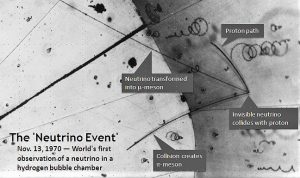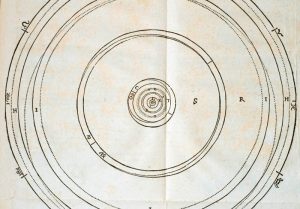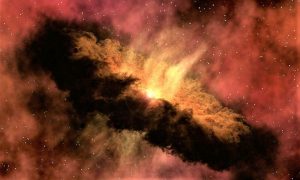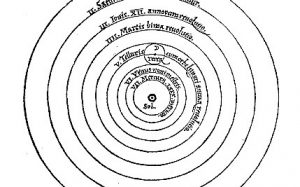Neutrino
Also known as the phantom particle or chameleon particle, the neutrino is an elementary particle of matter, very numerous in the universe but incredibly difficult to detect. It is a fundamental particle within the electron family that does not possess any type of electric charge.
What is a neutrino?
Subatomic fundamental particles that make up the universe and have a neutral charge. They have mass although it is not known exactly which one is and in addition, it is very similar to the electron.
Definition of neutrino
Neutrinos are one of the fundamental particles that make up the universe and at the same time, are the least understood particles. They are similar to electron we know regularly, with one crucial difference being that neutrinos do not have any kind of electrical charge. Since neutrinos are electrically neutral, they are not affected by electromagnetic forces acting on electrons. Neutrinos are affected only by a “weak” subatomic force with a much shorter range than electromagnetism and are therefore capable of crossing great distances in matter without suffering any kind of affectation.
History
What we know today from science is that most of the neutrinos that float was born about 15 billion years ago, shortly after the universe was born. Since then, the universe has continuously expanded and cooled, and neutrinos have continued.
The neutrino was first postulated in December 1930 by Wolfgang Pauli to explain the energy spectrum of beta disintegrations, the decomposition of a neutron into a proton and an electron. Pauli theorized that an undetected particle was carrying the observed difference between the energy and angular momentum of the initial and final particles. Because of its “ghostly” properties, the first experimental detection of neutrinos had to wait 25 years after it was first discussed. In 1956, Clyde Cowan, Frederick Reines, F. B. Harrison, H. W. Kruse and A. D. McGuire published the article “Free Neutrino Detection: A Confirmation” which was rewarded with the 1995 Nobel Prize.
Characteristics
The main characteristics of neutrinos are as follows:
- They are as fast as the speed of light.
- They are very small particles, almost like electrons.
- They interact with practically nothing in the universe.
- It is very difficult to detect even though there are millions of them.
- They don’t have any kind of electric charge.
- They are emitted by the stars and by the atmosphere.
- They can also be created by beta radioactivity.
- It has zero or very little mass.
- They have little interaction with matter.
- They are not affected in any way by strong electromagnetic or nuclear forces, but they are affected by weak nuclear and gravitational forces.
What are they for?
The neutrino is an elementary particle which means that it cannot be subdivided into other particles. This type of particle is an essential part of all the blocks and everything that exists in the universe.
Types
There are three types of neutrinos: electronic neutrinos ( ne ), muonic neutrino ( nm ) and tauonic neutrino ( nt ) plus their respective antiparticles. They have the ability to pass from one family of neutrinos to another through a process known as neutrino oscillation. The oscillation that occurs in neutrinos directly implies that they have a non-zero mass.
Neutrino sources
The main sources of neutrinos are:
- The Sun: it is the most important source in neutrinos production, and they are born from it through the processes of beta disintegration of its nucleus reactions. They escape freely from the solar nucleus through the Earth.
- Human sources: the main sources in charge of creating artificial neutrinos are nuclear power plants. These plants can generate about 1020 antineutrinos per second, and to a lesser extent, particle accelerators.
- Astrophysical phenomena: in type II supernovae, they cause the expulsion of the star’s mass into the interstellar medium. This emission of energy that is made in the form of neutrinos is very large and only a small part is transformed into light and kinetic energy.
Detector
Detectors based on radioactive processes
In 1967 Raymond Davis was able to find a neutrino detection system when he observed that chloro-37 could absorb a neutrino to become argon-37.
Detectors based on the Cherenkov effect
They were based on the collision of neutrinos with electrons contained in an aquatic medium. These detectors are based on the fact that the neutrino, when it hits an electron, passes part of its moment, giving it a speed higher than that of light in the same aqueous medium. There is a characteristic light emission, known as Cherenkov radiation, captured by the photomultipliers that cover the walls of the container.
Neutrino oscillations
The phenomenon of neutrino oscillations is related to the masses, because they allow neutrinos to pass from one to another along their path. Oscillation experiments allow us to know many of the properties of neutrino masses, but oscillation does not keep information about their value.
Importance
Neutrinos are one of the essential ingredients of the universe, and they have played a very important role in helping scientists understand some of the most fundamental questions in physics. They are important for understanding the type of processes that occur under the sun, and they are also an important building block for nature’s master plan.
How to cite this article?
Briceño V., Gabriela. (2019). Neutrino. Recovered on 3 January, 2025, de Euston96: https://www.euston96.com/en/neutrino-en/










